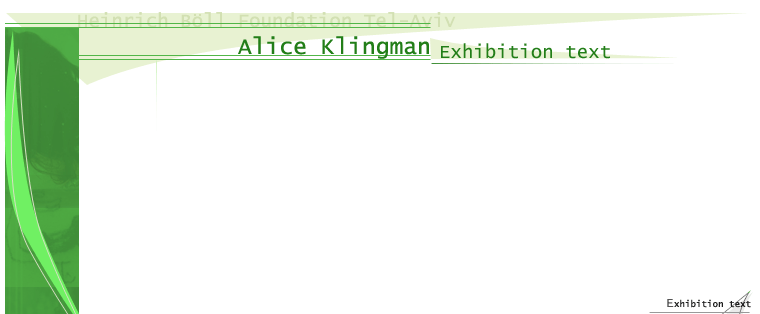


Alice Klingman - "Seven on the Wall"
Images of a wrapped body, bandaged, strangled, a length of cloth is stretched around the body's limbs, stretched endlessly tight. It is nakedness without nakedness, an outlined feminine body, the contours of the body are emphasized but the flesh is unseen, it is not present. The strip of cloth erases in horizontal lines the vertical lines, a process of erasing, almost a sketch that creates a tranquil graphic surface. The body is present as a graphic image, almost an "icon". The "icon" pushes the live flesh, the feminine nakedness, under the surface and creates an image part alive part dead. Is it a body wrapped in cloth or a mantle empty of content?
The erased and covered flesh contrasts the sensuality of the clinging plastic and the frozen chicken defrosted by the heat of the flash. The succulent chicken on a sexual hot red background, photographed from a viewpoint of the lower part of the body, a viewpoint that emphasizes the place of penetration into the body, the internal parts and the sexuality of the fresh meat. The Feeding bottles that have been melted down present a clear tangible materiality, an erasure of motherhood, of the feminine "icon" standing human-size on the facing wall.
The Photographic works describe intermediate states of covering and concealment, externalization and repression of the feminine body. The images: a mummy, feeding bottles and defrosted chicken, present a set of signs in irreversible processes of change. The defrosted frozen chicken will be thrown at the end of the shooting to the garbage bin, uneatable, dysfunctional. The bottles that have been melted down have become a shapeless plastic blend, a substance without function. And the feminine body will be fixed in our memory as fleshless, lifeless, and purposeless. The process of transformation is finite. But the decree of death, the destruction decreed on the act identified with the object exposes the material and creates it as the thing itself, as the essence of the object. Th emphasis is from the mark of the act to the mark of the material. The objects mark, fixate the transition point as timeless. They give up their functionality and become material, material that is everything.
From the first mummies, all the inner organs were taken out first, and later on the heart was taken out of the body through the eyes and the nose. The body remains empty, substance-less and filled with bags of sodium. But since it is dried-out and flesh-less, it has become a vessel, a suitcase for the soul in its travels to the world of the dead, and in that it has become substance again. The eyes have been marked as the mirror of the soul, as a place of consciousness, of life. In the transition between the covered-eyed and the open-eyed figures, there is no beginning, middle and end, no before or after the covering. The eyes know the body and know/see/confirm the act performed on it. They mark the range of possibilities on the continuum of knowledge of the body, before the covering, as an act that is aware of itself-or after the covering, as the possibility of reincarnation, retransformation or reconstructing the act out of the material.
The repressed flesh beneath the surface represents a sexuality that will break out of its boundaries. The flesh of the feminine, sexual, exposed body is the motive for the act, it marks the possibilities of the action with the body and on the body. but since the flesh is concealed, part bandaged and protected, part strangled to death, it gives up its functionality, i.e. the ability to carry out the range of its actions, and becomes material. The material becomes material. The flesh is only flesh.
The relations between consciousness of the act and consciousness of the flesh are arbitrary. The act does not stem from the flesh (the eyes confirm a body that does not exist), and the flesh does not produce or cause the act (sexual, for instance). These sets of signs exist simultaneously, while undermine each other. By rereading the photographs, in the transition from consciousness of an act to consciousness of material and vice versa, the body is emptied both from the acts identified with it and from consciousness of the flesh. It becomes more and more the sign of a body, an "icon". The "icon" becomes a sign that can be converted for every act or material, thus intensifying its image as an "icon", as the representation of an object with eternal life.
Curator: Tal Ben-Zvi
 |
|
|||
|
|
|
|
||
|
|
|
 |
|
|
|
|
|
|||
|
|
 |
|
||